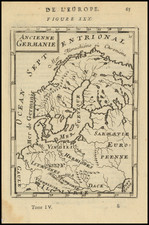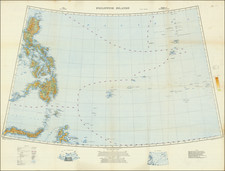Extraordinary Defensive Plan of Berlin, Prepared by Nazi Forces on the Eve of the Soviet Capture of the City and the End of World War II in Europe. This Map was Captured by Soviet Soldiers and Bears an Inscription in Russian in the Upper Left Corner.
An extremely detailed map of Berlin from the end of World War II. The map records the minute details of the end-game defensive plan for the capital, which was termed "Fall Clausewitz" or "Operation Clausewitz". The map is the standard-issue 1:100,000 RfL map of the Berlin region, but it has been substantially amended with hundreds of manuscript changes.
By early 1945, the Germans had all but lost the war on Eastern Front. The Red Army proved an unstoppable tidal wave, destroying the Wehrmacht division by division. Evacuation measures for Berlin had been prepared for the Reich government, ministries, and security apparatus starting in February of 1945. However, their implementation was delayed so that the commanders would not be seen to be admitting defeat. With two million Soviet soldiers quickly surrounding Berlin, Adolf Hitler finally gave the order to execute the defensive plan for the city on April 20th, 1945, his 56th birthday.
Operation Clausewitz: The Final Defense of Berlin
This map shows the main elements of the defensive plan for the city. Berlin was divided into nine defensive subsections. A-H for the regions around the city, and Z for the city center (varyingly reported as "Zentrum" or "Zitadelle"). Those sections are labeled and delineated here. Furthermore, the Berlin region was divided into an "Outer Restricted Zone", an "Outer Defensive Zone", and finally an "Inner Defensive Zone", also shown here.
The map goes into much fine detail. It calls for hundreds of bridges to be blown up; many of them were already prepared for that when this map was drawn. The map delineates overlapping lines of anti-tank barriers, trenches, and roadblocks. To the south of the city, floodplains are mapped, presumably so engineers could open dams and inundate the areas.
Maker and Date of Production
Based on the information included on the map, we can make educated guesses about the authorship and date of production of the map.
The map's information is broad, detailed, and extremely sensitive. As there would have been no reason for even defensive section commanders to have comprehensive plans for the defense of the city, we can reasonably conclude that the map would have been prepared for either Helmut Weidling (the general in charge of the defense of Berlin), his staff, or central command at the Führerbunker.
As the map depicts the implementation of Operation Clausewitz and makes allusion to "main battle lines", we can reasonably conclude that it was annotated in a brief window during, or shortly after, the Battle of Seelow Heights (April 16-19) but before the Soviet armies began penetrating the Berlin defenses on April 23.
Conclusion
Three days after Hitler implemented Clausewitz, the first Soviet ground forces started to penetrate the Berlin suburbs. Four days after that, Berlin was surrounded and cut off from outside assistance. Within a week, the city would fall and six days later World War II would end in Europe.
The present map has considerable research value for historians of the Second World War; as far as we can find, this is the only extant map to show a general overview of Clausewitz defenses for all of Berlin. The map was certainly used by the highest echelon of Nazi command in planning for the Battle of Berlin. It probably survived the purge of Nazi documents and orgy of destruction in the city only because it was captured by a Russian soldier.
This map was prepared for a defensive stand that never fully materialized. The Red Army's envelopment of Berlin was so quick and decisive that the maker of this map would have had little cause to update it as events unfolded, if he was even alive to do so.
Appendix: Translation of the Manuscript Key
Zeichenerklärung [Explanations]
H.K.L. [Main battle line]
Innerer verteidigungsring [Inner defense ring]
Äußerer verteidigungsring [Outer defense ring]
Äußere Sperrzone [Outer restricted zone]
Abschnittsgrenzen [Section boundaries]
Strassensperre geplant [Roadblock planned]
Strassensperre im Bau [Roadblock under construction]
Strassensperre fertig (geschlossen) [Roadblock finished (closed)]
Baumsperre [Abattis]
Scheinsperre [Fake barrier]
Höckersperre [Dragon's teeth anti-tank barrier]
Pfahlsperre [Anti-tank piles]
Panzergraben geplant [Anti-tank ditch planned]
Panzergraben im Bau [Anti-tank ditch under construction]
Panzergraben fertig [Anti-tank ditch ready]
Brückensprengung geplant [Bridge blowing planned]
Brücke geladen (ohne eingeführte zündung) [Bridge loaded (without ignition)]
Kletterwand [Climbing wall]
Kampfgraben [Battle ditch]
Überstautes Gelände [Flood plain]
Versumpftes [Marshy]
Brucke gesprengt [Bridge blown up]
By early 1945, the Germans had all but lost the war on Eastern Front. The Red Army proved an unstoppable tidal wave, destroying the Wehrmacht division by division. Evacuation measures for Berlin had been prepared for the Reich government, ministries, and security apparatus starting in February of 1945. However, their implementation was delayed so that the commanders would not be seen to be admitting defeat. With two million Soviet soldiers quickly surrounding Berlin, Adolf Hitler finally gave the order to execute the defensive plan for the city on April 20th, 1945, his 56th birthday. The defenses barely slowed down the Red Army, and by early May they had totally subdued the city.









![Basic Field Manual | Elementary Map and Aerial Photograph Reading [Booklet with double-sided folding map]](https://storage.googleapis.com/raremaps/img/small/90597.jpg)

![[World Map / Malaria / Dr. Seuss ] This is Ann . . . She drinks blood!](https://storage.googleapis.com/raremaps/img/small/73499.jpg)


